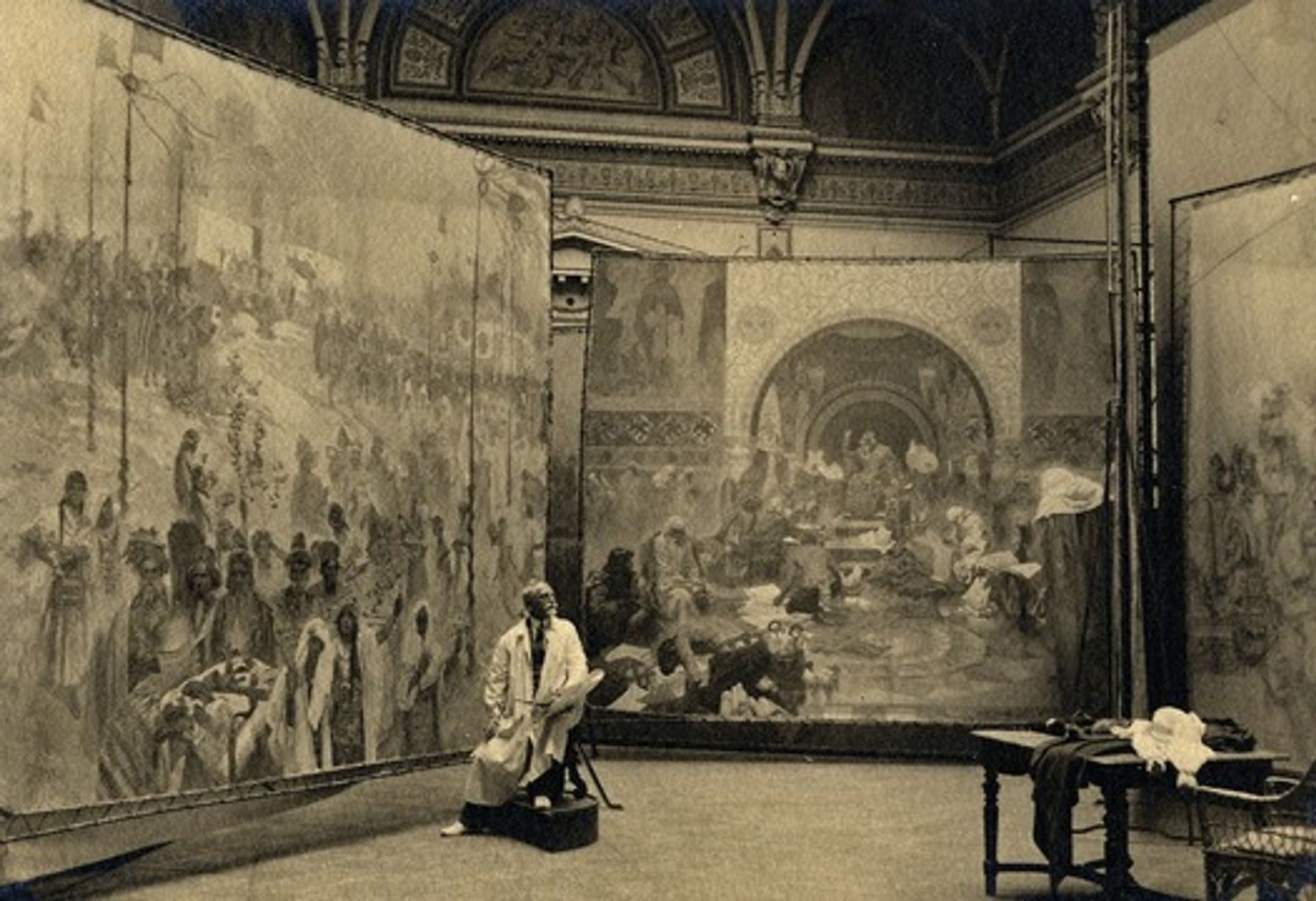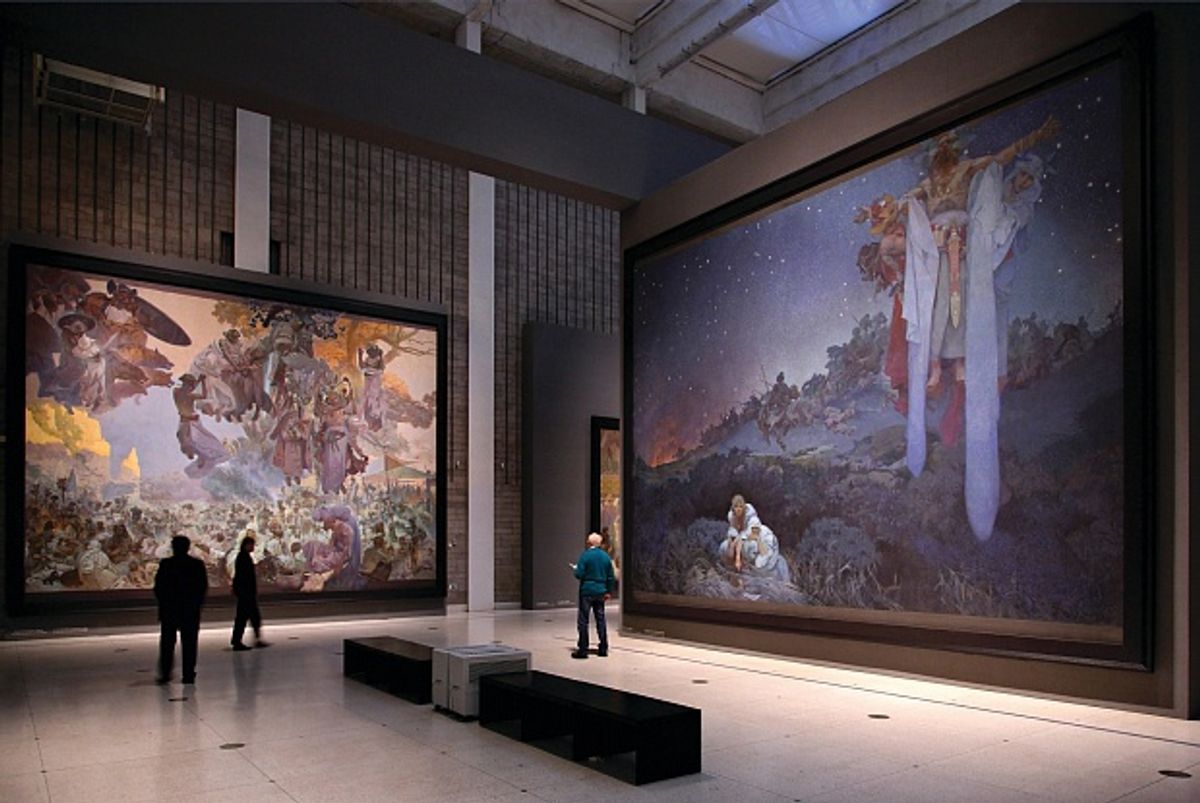A major legal battle looms over Alphonse Mucha’s monumental Slav Epic. The gigantic canvas cycle, which took the Czech-born Art Nouveau pioneer 18 years to complete, is due to go on a controversial tour to Asia, which has alarmed Mucha’s descendants and some conservators.
The Slav Epic depicts key events in the history of the Slavic people through 20 large paintings—some more than eight-metres tall. It is a rare work on canvas by Mucha (1860-1939) who is best known for his advertising posters and designs that became synonymous with Belle Epoque Paris. Mucha, along with Charles Crane, the US philanthropist who funded the work, presented the Slav Epic as a gift to the city of Prague in 1928, the tenth anniversary of Czechoslovakia’s independence. But the donation came with the condition that the city build a space for the cycle to be exhibited permanently. Almost 100 years on, a gallery has yet to be constructed.
Now, the city of Prague wants to send the Slav Epic to museums in Asia for a two-year tour, which could be extended to South Korea and the US—the first time all 20 works will be displayed together outside the Czech Republic.
To prevent them from leaving the country, John Mucha, the artist’s grandson and the president of the Mucha Foundation, filed a lawsuit against the city of Prague on 11 April. He argues that Prague, having failed to build the gallery, never became the full owner of the Slav Epic, and that the works should therefore be returned to Mucha’s heirs. The first court hearing is scheduled to take place on 18 January. The Czech Republic’s ministry of culture is yet to issue an export permit for the Slav Epic, which is registered as a national treasure.
“Alphonse was a patriot and wanted the work to be enjoyed in perpetuity by the Czech people,” John Mucha says. “To that end, he gave it to the city of Prague on condition that it build a pavilion in which it could be exhibited to the public. But the city has not fulfilled that condition.” Since 2010 the Slav Epic has been on display at Veletrzní Palác, a former venue for industrial fairs in Prague, which “some leading conservators consider unsuitable to works of this type and magnitude”, according to Mucha.
International tour
It was controversially moved there from Moravský Krumlov in the southern Moravian region, where it had been on display for 50 years. The Mucha family also has emotional objections to the Veletrzní Palác: during the Second World War, the venue was a holding area for Jews—including members of Mucha’s family—before they were deported to concentration camps.

Alphonse Mucha with the Slav Epic in the 1920s © Mucha Trust 2016
The city’s lease on Veletrzní Palác will run out in December, giving the museum a month to dismantle the exhibition before sending it abroad. The tour is scheduled to begin in Japan at the National Art Center in Tokyo (8 March-5 June 2017), before travelling to China, where the works will be shown at the Nanjing Museum (14 July-8 October), the Guangdong Museum (November-January 2018) and the Hunan Provincial Museum in Changsha (February-May 2018). Venues in South Korea and the US are being negotiated.
“The canvases are huge and are very sensitive as they are oil and tempera on canvas,” John Mucha says. “As such, any touring risks permanently damaging the art—particularly as some of the Chinese museums at which the Epic will be exhibited have never hosted exhibitions of Western paintings of such size and technical complexity before, and are unlikely to have the required conservation expertise to handle such works.”
Conservators have also criticised the plans. “The more Mucha is handled, the less Mucha there is,” says Zuzana Poláková, a restorer of paintings at the Slovak Academy of Sciences, in a statement. “Works from Mucha’s Epic have been exhibited abroad several times in the past and they have always needed restoration. Damage is caused by the repeated rolling and unrolling of the canvases and changes in climate.” The Association for the Conservation and Development of Cultural Heritage in the Czech Republic, which has appealed to the country’s ministry of culture to stop the tour, has also pointed out that after an investigation in 1936 a commission appointed by Prague city council recommended that the Epic never be allowed to travel abroad again.
No permanent home
The head of Prague City Gallery, which cares for the Slav Epic and is organising the exhibitions, says that the tour poses little risk to the works. “If these venues can display ancient art, Renaissance paintings, classic Modern art and other fragile works of art from several European destinations by artists such as Da Vinci, Raphael, Titian, Lorenzo Lotto, Rodin, Picasso, Léger and Dubuffet, they will apply the same care in showing works by Mucha—even if they are monumental,” says Magdalena Juríková, the gallery’s director, adding that the museum is working towards ensuring adequate conditions of transport and display at the exhibiting venues.
Juríková says that “two world wars and a totalitarian regime” have impeded the search for an appropriate space for the Slav Epic. (When the Nazis entered Prague in 1939, the works were rolled up and hidden until they were re-exhibited in 1963.) “The present political body is paying attention to this subject. I have been in my seat [as the director of the Prague City Gallery] for three-and-a-half years and have tried to solve [the issue of] the future display of the Slav Epic continuously throughout this period,” Juríková says.
Nonetheless, the international tour has forced his hand, John Mucha says. “If I didn’t do anything and the Epic was destroyed or it never found a space, I would be kicking myself until I was dead. If I lose, at least I can sleep peacefully because I will have done everything possible to fulfil the wishes of my grandfather and to protect the Slav Epic.”


